Duluth: Bird City
Raptors: The sight of a bald eagle stirs a person. I used to live in more southerly climes where they were less common, so it has been a treat to see one every now and then up here. I saw them a lot after my divorce, when I had to drive halfway through Minnesota every two weeks to exchange my daughter like a prisoner. I pointed out bald eagles to my child on these drives, barely able to contain my excitement, while she did that kid act of being bored with everything. Later I visited her at her mom’s house in a rural Winona valley. There was a field of tilled earth on the dirt road to their home, and it was positively overrun with bald eagles. As I drove past, I saw fifty of them together walking around in the mud with their dirty talons. I said to my daughter, “Now I understand why you’re never excited to see a bald eagle — you see so many of them every day, they’re like rats here.” She said, “Yup.”
Hawk Ridge overruns with bird nerds. Hawks soar over the city alone or in twos and threes, or by the dozen during migration. Cold air off the lake hits the warm hillside, a clash of airmasses creating lift — they love that. Unimaginably high with laser vision watching for unwary pigeons or rabbits, eating them on the roofs on people’s houses. I saw feathers raining past my window one day. By the time I figured out a hawk was eating a pigeon on my roof, it was gone.
From the bar at Zeitgeist I watched the peregrine falcon nest on the edge of the roof of Greysolon Plaza. Drama unfolded as the mom and dad hawks circled and dived — their babies were being tagged by biologists. I would not like to get on the wrong end of a falcon.
I have neighbors a couple doors down whose kids went to daycare with my daughter years ago. They have a tall roof, and one day I saw a quite large turkey vulture perched there, eyeing a roadkill squirrel down the block. I messaged them, saying, “There’s a pterodactyl on your house.” By the time they came out to look, it was pecking the carcass in the road. Then it took off, winging toward my house. The urge to video it distracted me from the sight. So I left my camera alone as it whooshed right by me on the balcony, my own little perch here in Bird City.
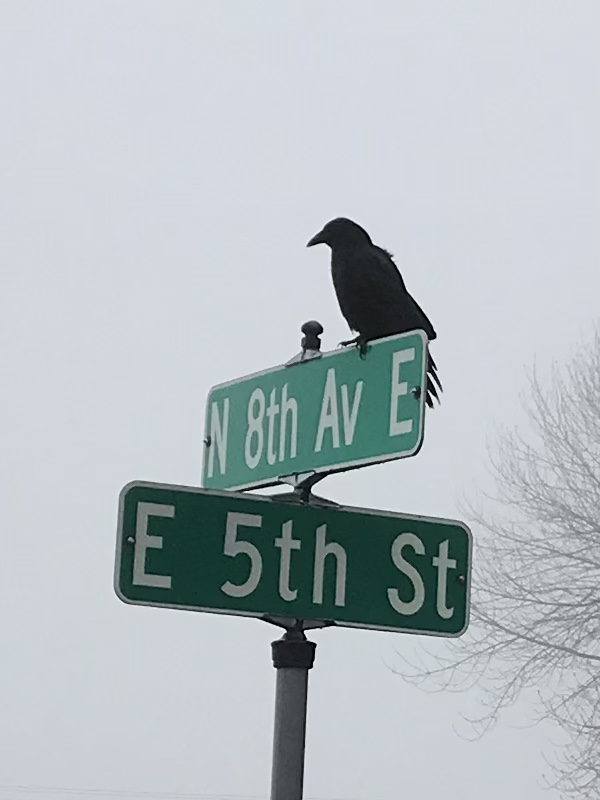
A crow in Bird City. (Photo by Jim Richardson)
Corvids: One of my earliest impressions of Duluth was its oversized ravens, big as chickens here. Their cousins the crows methodically patrol the hillside, fighting over scraps, waking me on summer mornings when I sleep with the windows open. One just buried a large piece of bread in my lawn under grass clippings. Crows drinking out of gutters. Crows in winter warm themselves on the exhalations of chimney tops. Seated high on branches or wires, they call as I walk by. I remain convinced the alarm calls of the corvids will be understood one day as words in a tonal language. The crow on the telephone pole keeps watch, calling to his family and friends in the road, who are eating a flat pigeon: “Here comes that guy! You know the one! Look out!” They scatter to the trees until I pass, then the lookout calls: “The coast is clear!” A crow idly scratches itself perching on a wire watching the sunset. It’s been a long day.
Songbirds: Bird species keeping track of each other in the fluent Babylon of Bird City, joining politically to chase hawks as alarm calls sound. They all know each other’s alarms. A robin on the house across the street announces fall with a warbly jumble of gargled notes. Robinsong triggers childhood memories of Maryland summer, robins calling in soft light as I tried falling asleep — for a while I confused red-winged blackbirds with the orioles of my boyhood. Robins eating worms in the road after rain. Starlings poking around en masse in the grass. Chickadees calling “Yoo hoo! Hey girl.” Cardinals making laser battle sounds. Grackles beeping and making siren noises. Shakespearean dramas among birds: egg murder, violence on the wing, displays of strength and subterfuge in the daily hustle. Don’t forget bluejays, nature’s little assholes. Blue eggshell fragment on the sidewalk. Eggs lost to nest-raiders stimulate the reproduction cycle. The robin lovers touch cloacas. Nesting is innate, not cultural, although it is an ongoing conversation. The art of stitching sticks into a bowl — is there a gene for it? Is there a gene for art?
Pileated Woodpeckers: I dated a hiker who freaked out every time we saw their insouciant red mohawks in the woods, which was kind of a lot.
Pigeons: Evolved in canyons on cliff faces, translating easily to cities and skyscrapers. Their short wings enable tight turns to escape predation from the air as they weave and dodge. Iridescent plumage dulled by grime does not significantly affect reproductive fitness. Pigeons mating doggy style on the downtown sidewalk.
Seagulls: I ask myself, did they get here on their own, or did they follow ship traffic? Baby-like screaming calls eerily like a child in distress. A seaside lover confessed to me her love of the gull. She said despite their reputation as sky-rats worse than pigeons, she wished to be one, praising their freedom and grace on the wing. Seagulls dive bomb me on the lake — their kids are nearby. Gulls chase ships to hunt the small fish churned up in the wake. I saw a dead gull in the woods of Park Point. It lay on its belly on the forest floor, wings spread cruciform, bright white neck curled in the death posture. We were doomed.
Canadian Geese: The “V” means changing seasons. The V is an aerodynamically efficient way for a group to fly, surfing each other’s wake. Only the goose at the front has to work harder than everybody else, but they switch out, merge with other Vs, break apart into diagonal line segments, recombine over distance and in fog, always honking so the group mind gets a regular ping from everybody. The pond at Forest Hill Cemetery is a favorite haunt; their shit fertilizes the graves.
Blue Herons: Saw one at 5:45 in the morning in Chester Creek. It was knee deep in a pool, still, fishing. I was on my way to work at Whole Foods Co-op’s old location, now Burrito Union, cutting through the creek to get my bread and butter. The heron and I were both working early.
Pelicans: I was on the empty Lakewalk by the Vietnam Memorial one fall Sunday morning. A lone pelican came flying down the shore, and continued over Canal Park to the inner harbor and the St. Louis River. I had two thoughts. 1.) That bird better head due south like yesterday or it will find itself trapped in bad weather. 2.) Did I really just see a pelican? I better not tell anybody or they’ll think I’m crazy. I’ve seen pelicans on the coasts flying low over ocean waves in undulating formations, following each other tight like fighter pilots. But I’d never seen one on the inland sea. Looking it up later, it’s a thing, they just follow the water. So they and the seagulls found Lake Superior long ago.
Snowy Owls: The one snowy owl I’ve seen was during the People’s Free Skate in 2019. There was a bunch of us on the 100 percent frozen-over lake which was covered in snow from here to Sault Ste. Marie. Except for our shoveled skateways, the lake was a featureless plane like we were on Ganymede. The low light faded but Tomas Soderberg kept his camera rolling. A large white bird swooped out of the sky (at the 45-second mark in the embedded video below). My mind raced to identify it. At first I thought it was a seagull because those are the only large white birds one usually sees around here. But I was confused because it was the deep winter, and the seagulls seemed to have evaporated. And the wingspan was larger, the wing shape different. It hit me in a flash that it was a Snowy Owl and I stopped skating to get a better look at it. It alighted on the lake in the distance, vanishing instantly in perfect camouflage. All who’d seen the visitation felt weirdly graced.
Sandpipers: Tall ones on long legs wading through the shallows, short ones chasing waves and running away, sandpipers of different colors, patterns, and body plans flocking together in shorebird solidarity.
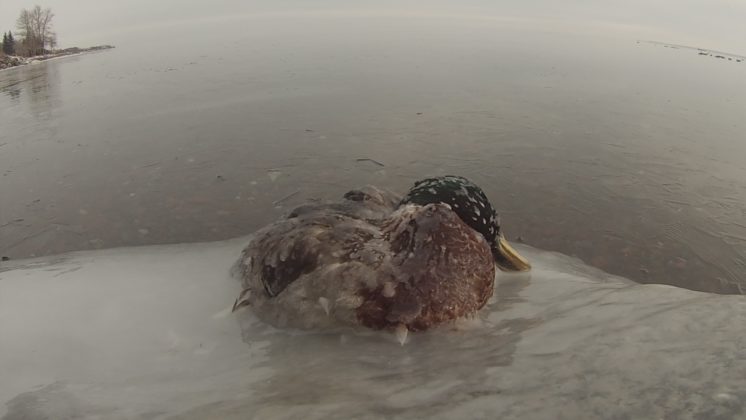
A dead duck in Bird City. (Photo: Jim Richardson)
Ducks: The mallard pairs I’ve seen are gentle and sweet. It seems to me he is following her as if they are a matriarchal society. Duck families normally keep well away from people on the shore but occasionally they show their babies off a little closer in. Mallards congregate at the corner of the Lakewalk in winter where it may be a degree warmer and there’s a windbreak. A drainage pipe empties there and sometimes it makes a little pool when everything else is just ice, and that dirty pool can be stuffed with chilly ducks. I found a dead mallard nearby once, it had died on a half-submerged boulder washed by waves before the water froze. Its body shellacked, emerald green head ice-flecked, large flock of ducks in the distance. I told my bird-watcher friend about it and she was alarmed a duck had died in the middle of this harsh winter. I said, “I don’t think it’s sign of anything except not every duck is going to make it.” Other Bird City ducks include wood ducks and diving waterfowl, like the black-and-white ones — there are several kinds — with an orca whale look. When the harbor and the lake are frozen, sometimes the water of the canal remains open. They flock there, diving 40 feet to the silty bottom of the canal to look for food.
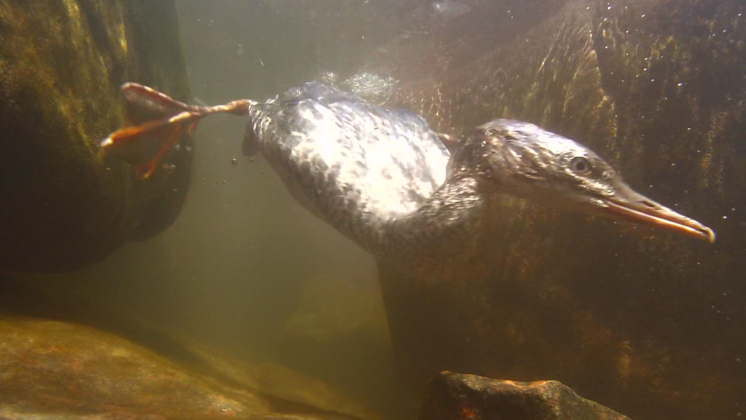
A juvenile merganser in Bird City. (Photo: Jim Richardson)
Mergansers: Haunting the rocky shores of the Ledges in summer, I sync to the rhythms of the mergansers. They nest up in the rivers and streams, but during the day they enter Lake Superior. Mornings they swim down the shore, diving and fishing the whole way. In late afternoon/early evening, they swim back, keeping bellies full. When it’s a mother and her babies, she shows them all the best places. The underwater terrain there, sandy floor littered with boulders and rock outcrops, provides places where fish hide. The mergansers dive as a pack sticking their serrated beaks into every nook and cranny. The alarmed fish make a run for it. The mergansers are scaring fish into each other’s mouths. One year I regularly spied a merganser mama and her adolescent children hitting up a group of shallow boulders as they went down shore, and then they hit it again on the way back home. It was a drive-through restaurant. I saw lots of fish when I stuck my waterproof camera down there. I realized I could get underwater pictures of mergansers hunting if I timed it right, my greatest victory as a photographer.
Loons: By the Ledges townhomes there is a great rock at the water’s edge. As I stood there looking down into the deep clear water, a loon swam like a torpedo right by my feet. Large, powerful birds, they are heavy with solid bones for diving and prehistoric red eyes for underwater vision. Their beaks are pointy enough to pierce an eagle’s heart. They are more solitary than mergansers but occasionally you see them in pairs or more. What I think was a loon snuck up on me when I was in the water and peeked at me before disappearing; I wasn’t even aware of it until I reviewed the video months later. Once I dated a woman whose mother lived on Round Lake. The mom swore to me that if a loon was too injured or sick to migrate south for the winter, it would swim to the bottom of the lake and drown itself. I rarely hear the mournful cries of loons in Duluth, perhaps because in Bird City they have everything they need.
An index of Jim Richardson’s essays may be found here.
Recommended Links:
Leave a Comment
Only registered members can post a comment , Login / Register Here


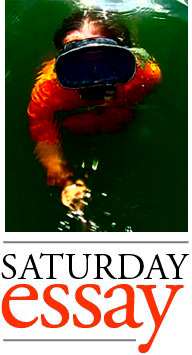

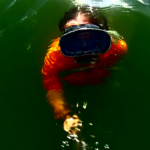









3 Comments
Matthijs
about 2 years agoJim Richardson (aka Lake Superior Aquaman)
about 2 years agoMatthijs
about 2 years ago